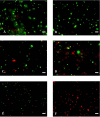Squalamine: an appropriate strategy against the emergence of multidrug resistant gram-negative bacteria?
- PMID: 18648511
- PMCID: PMC2447875
- DOI: 10.1371/journal.pone.0002765
Squalamine: an appropriate strategy against the emergence of multidrug resistant gram-negative bacteria?
Abstract
We reported that squalamine is a membrane-active molecule that targets the membrane integrity as demonstrated by the ATP release and dye entry. In this context, its activity may depend on the membrane lipid composition. This molecule shows a preserved activity against bacterial pathogens presenting a noticeable multi-resistance phenotype against antibiotics such as polymyxin B. In this context and because of its structure, action and its relative insensitivity to efflux resistance mechanisms, we have demonstrated that squalamine appears as an alternate way to combat MDR pathogens and by pass the gap regarding the failure of new active antibacterial molecules.
Conflict of interest statement
Figures






Similar articles
-
New insights into the antibacterial mechanism of action of squalamine.J Antimicrob Chemother. 2010 Aug;65(8):1688-93. doi: 10.1093/jac/dkq213. Epub 2010 Jun 15. J Antimicrob Chemother. 2010. PMID: 20551217
-
In vitro antibacterial activity of aminosterols against multidrug-resistant bacteria from patients with cystic fibrosis.J Antimicrob Chemother. 2009 Oct;64(4):810-4. doi: 10.1093/jac/dkp281. Epub 2009 Aug 7. J Antimicrob Chemother. 2009. PMID: 19666647
-
Outer Membrane Interaction Kinetics of New Polymyxin B Analogs in Gram-Negative Bacilli.Antimicrob Agents Chemother. 2019 Sep 23;63(10):e00935-19. doi: 10.1128/AAC.00935-19. Print 2019 Oct. Antimicrob Agents Chemother. 2019. PMID: 31332075 Free PMC article.
-
Regulating polymyxin resistance in Gram-negative bacteria: roles of two-component systems PhoPQ and PmrAB.Future Microbiol. 2020 Apr;15(6):445-459. doi: 10.2217/fmb-2019-0322. Epub 2020 Apr 6. Future Microbiol. 2020. PMID: 32250173 Free PMC article. Review.
-
An original deal for new molecule: reversal of efflux pump activity, a rational strategy to combat gram-negative resistant bacteria.Curr Med Chem. 2011;18(19):2969-80. doi: 10.2174/092986711796150469. Curr Med Chem. 2011. PMID: 21651484 Review.
Cited by
-
Squalamine and Its Aminosterol Derivatives: Overview of Biological Effects and Mechanisms of Action of Compounds with Multiple Therapeutic Applications.Microorganisms. 2022 Jun 13;10(6):1205. doi: 10.3390/microorganisms10061205. Microorganisms. 2022. PMID: 35744723 Free PMC article. Review.
-
Squalamine and claramine A1 disperse Pseudomonas aeruginosa biofilm.Biofilm. 2025 May 27;9:100293. doi: 10.1016/j.bioflm.2025.100293. eCollection 2025 Jun. Biofilm. 2025. PMID: 40519941 Free PMC article.
-
In-vitro archaeacidal activity of biocides against human-associated archaea.PLoS One. 2013 May 3;8(5):e62738. doi: 10.1371/journal.pone.0062738. Print 2013. PLoS One. 2013. PMID: 23658767 Free PMC article.
-
Mechanisms of resistance in bacteria: an evolutionary approach.Open Microbiol J. 2013;7:53-8. doi: 10.2174/1874285801307010053. Epub 2013 Mar 22. Open Microbiol J. 2013. PMID: 23560029 Free PMC article.
-
Cinnamaldehyde: a compound with antimicrobial and synergistic activity against ESBL-producing quinolone-resistant pathogenic Enterobacteriaceae.Eur J Clin Microbiol Infect Dis. 2020 Jan;39(1):65-73. doi: 10.1007/s10096-019-03692-y. Epub 2019 Oct 17. Eur J Clin Microbiol Infect Dis. 2020. PMID: 31624984
References
-
- Armstrong D, Neu H, Peterson LR, Tomasz A. The prospects of treatment failure in the chemotherapy of infectious diseases in the 1990s. Microb Drug Resist. 1995;1:1–4. - PubMed
-
- Bax R, Bywater R, Cornaglia G, Goossens H, Hunter P, et al. Surveillance of antimicrobial resistance-xhat, how and whither? Clin Microbiol Infect. 2001;7:316–325. - PubMed
-
- Tomasz A. Multiple-antibiotic-resistant pathogenic bacteria. A report on the Rockefeller University workshop. N Engl J Med. 1994;330:1247–1251. - PubMed
MeSH terms
Substances
LinkOut - more resources
Full Text Sources
Other Literature Sources
Medical
Molecular Biology Databases
Miscellaneous

